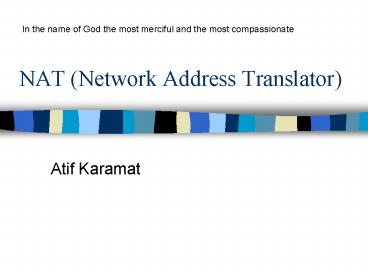NAT (Network Address Translator) - PowerPoint PPT Presentation
1 / 19
Title:
NAT (Network Address Translator)
Description:
Instead of requiring that each device behind the gateway have a globally unique ... Static mapping allows a static entry to be made in the mapping table which ... – PowerPoint PPT presentation
Number of Views:29
Avg rating:3.0/5.0
Title: NAT (Network Address Translator)
1
NAT (Network Address Translator)
In the name of God the most merciful and the most
compassionate
- Atif Karamat
2
NAT Is it Necessary?
- Scenario
- One High Speed Dial Up, Multiple Devices
- How to Share ?
- Solution Gateway, but it requires that each
device should have a unique IP address.. - IP addresses may become an endangered species
very soon..
3
NATThe Solution
- NAT
- Instead of requiring that each device behind the
gateway have a globally unique IP address, then,
we can allocate private addresses to such devices
and the gateway can then translate private IP
addresses in all traffic that passes through the
connection.
4
NAT Scenario II
- Network Security
- Denial of Service
- Trojan Horse Attacks
- NAT drops all unsolicited inbound traffic, which
minimizes threats of this kind.
5
NATWhat is It?
- NAT
- NAT exists primarily to allow machine on a local
network to share a single internet connection by
replacing the source address of each outgoing
message with the address assigned to the shared
connection.
6
NAT Components
7
NAT Requires
- To function NAT requires to
- Maintain a mapping between the original
addressing information and the replaced
addressing information. - Update the checksums to reflect the modifications
made.
8
NAT NAT Gateway
- The main component is the NAT Gateway. A basic
NAT Gateway has two interfaces. One interface to
public network and the other interface to private
network. - A more advanced NAT gateway may have multiple
interface i.e corporate network.
9
NAT Mapping Table
10
NATOperation
- Traffic generated by client is received on the
private interface. Gateway looks into the packet
header, extracts the header in to and creates an
entry in the mapping table. When the reply comes
back, NAT looks up in the mapping table and
directs the packet to the private client.
11
NAT Application I
- Address Port Translation
- Modification of source address and source ports
(out going packets). - Modification of destination address and ports
(Incoming packets).
12
NAT Application II
- Address Mapping
- A pool of private addresses is to be mapped to a
smaller pool of public addresses. - Mapping from private to public addresses are
established until no more addresses are
available. - At this point, NAT may switch over to translation
of port information.
13
NAT Application III
- Static Mapping
- To achieve security, the most important feature
is that no unsolicited traffic may pass through
NAT. But this feature prevents from hosting any
service behind NAT. - Static mapping allows a static entry to be made
in the mapping table which allows for unsolicited
incoming traffic, only for that entry.
14
NAT Constraints I
- Limited Port Numbers.
- Using IP addresses in Payload
- When the server on the public domain reads the
address of the client in payload it doesnt
recognize the private address. - Using Port number in payload
- This may cause a failure because some time the
port requested by a client is not available and
so NAT is forced to assign some other port number.
15
NATConstraints II
- Specifying port or range of ports
- The server side should not be programmed to
expect traffic from a specific port because the
client may not be able to get the specific port. - Assuming that IP address will remain same during
conversation - Mobile clients behind NAT
16
NAT Constraint III
- Assuming that Application can receive unsolicited
Inbound connections - Offering of any services behind NAT will fail.
- Primary control session to a port is followed one
or more secondary connection to different ports,
which will fail.
17
NAT Design Principles I
- IP address and port information shouldnt be
embedded in the payload. - Use fully qualified domain names and/or user
names where possible. Let DNS do the work. - Traffic shouldnt be required to originate from a
specific port number.
18
NAT Design Principles II
- Unsolicited inbound connections should be
avoided. - Encrypted protocols should avoid the checksum
cover the IP header, because NAT cannot decrypt
and change the IP header information by default.
19
NAT Application Level Gateway (ALG)
- When a protocol is unable to pass cleanly
through a NAT, the use of an Application Level
Gateway (ALG) may still permit operation of the
protocol.































